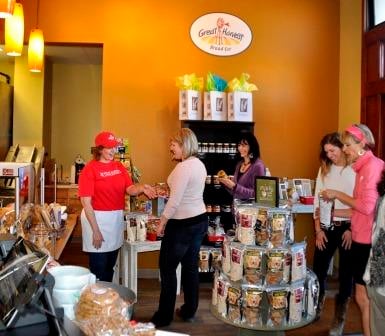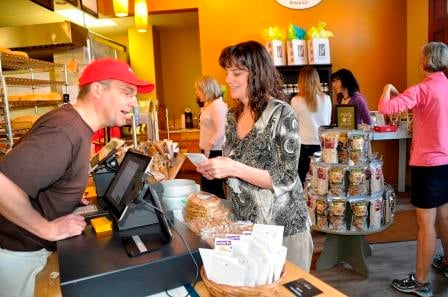We have studied this question about optimal bakery square footage over and over and over again and always find that, while we have an answer, we will always make reasonable accommodations to get the right space.
Which is a long way of saying, “It depends.”
What is your bakery business and product line model? Concepts generally come in small, medium and large sizes:
- small bakeries have a less diverse product line version and no seating,
- medium-sized local retail bakeries have a diverse product line with little or no seating, and
- large bakeries have a diverse product line and seating for customers.
In Great Harvest we have studied the absolute minimum number of square feet to run our concept and have quite a few stores at that level, which is less than 1500 square feet. From there up, you add lobby space. The tendency we advise against is to give elbow room in the production area. If you had enough production space at 1500, do you really need the extra space? That adds cost, not revenue.

More customer space adds revenue in the form of more product display or seating or just happier customers due to less crowding. Above 2200 to 2400 square feet, you start to hit a point of diminishing returns. At some point, too big is just too big. The business and atmosphere get swallowed.
We can do local retail bakeries smaller and larger. In fact we have a couple of stores under 1300 feet and one or two over 3,000. They work but they aren’t easy. In a more expensive market, I would certainly work to find how to reasonably do a smaller store. Whenever you go below the ideal, you are making tradeoffs so one must ask at what price?
Below about 2000 feet, you start to lose seating and merchandising space. Is that okay? Do you want a retail bakery with hang out space for families? Do you want a place for the lunch crowd to gather? If so, it is hard to be much below 2000 square feet.
Do you want to open a bakery where people just shop? Then you can get much closer to the low end of the range. The same is true if you want to be in an expensive location. If you want to be the neighborhood gathering place, then you need to account for that in size.

In general, the issues are more complex when you are trying to shrink your footprint than they are when you are trying to work with a bigger space. The pictures accompanying this blog are shots of our training bakery in Dillon, MT. It is less than 1200 square feet and really works just fine. The tradeoffs we have made are no seating, inconvenient storage, smallish lobby and a bathroom that isn’t accessible to the public (which we understand may not be an option in all cities.)
The point is that, while we are only open to the public 19 days a year in that training site, we do extremely high volume out of it on those 19 days. More than we do as a daily average across Great Harvest.
Size is a factor in what you can do with your local retail bakery but it isn’t the limiting factor you might expect.
As with most things in business, there is an answer to this question but it is adaptable. As it should be.




